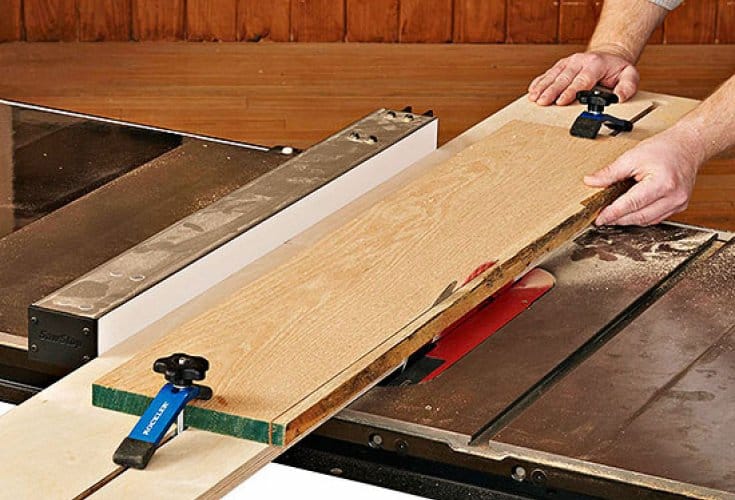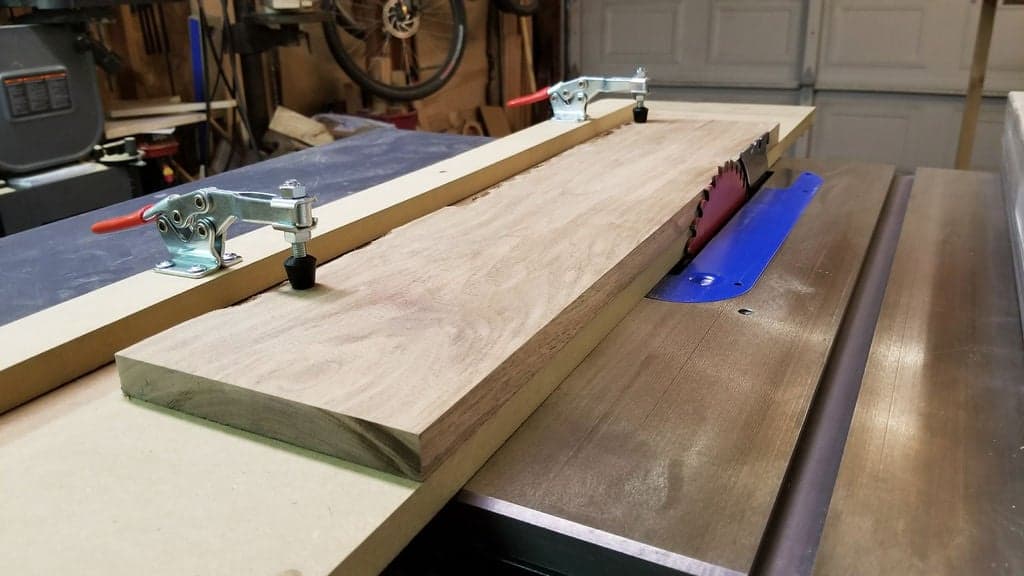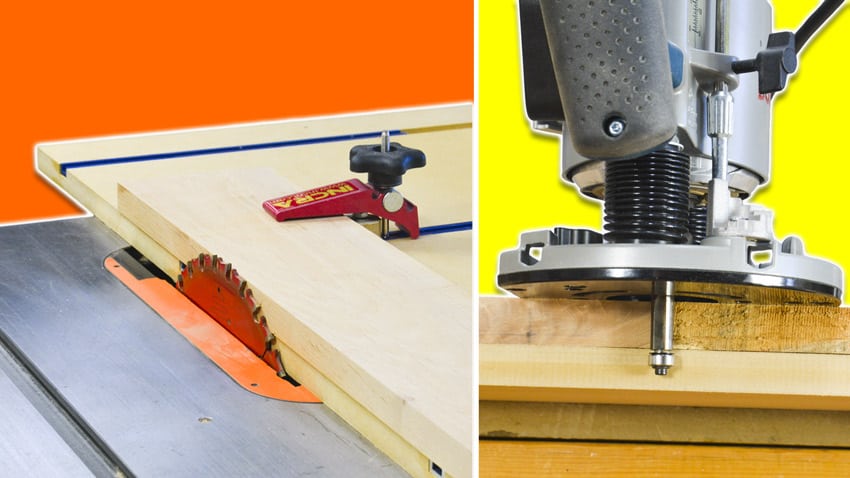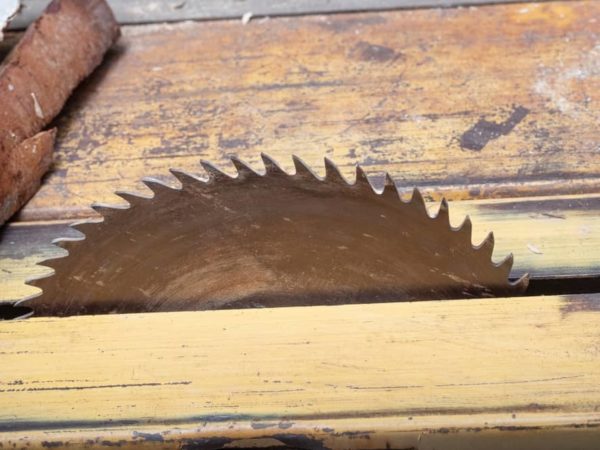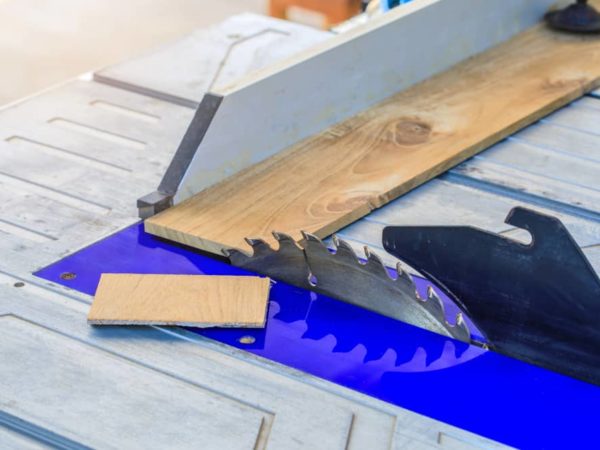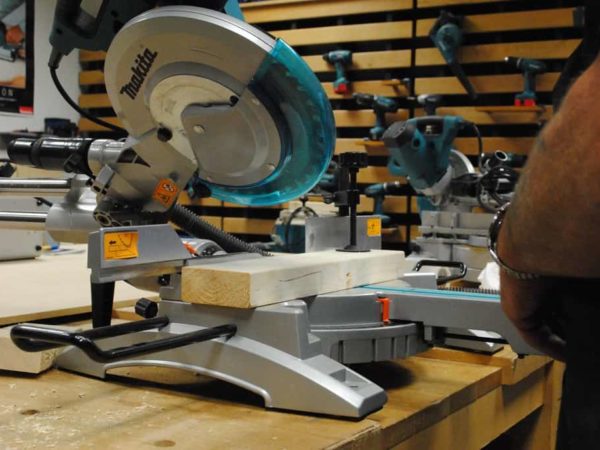For most woodworking tasks, we require perfectly flat and uniform boards – but unfortunately, boards straight from the store rarely arrive in this condition.
If you have warped or bent wood, the proper tool for correcting it is a jointer. However, for most home woodworkers, it isn’t practical to own one – but no problem.
If you have a table saw – from the largest cabinet table saws to more mobile jobsite table saws – you can use that too, so here are 11 table saw jointer jigs you can DIY easily.
Table of Contents
1. Building a Jointer Jig for Your Table Saw
It’s a story many woodworkers will be familiar with – you spend a great deal of time hunting through piles of wood trying to find the right piece of stock, but when you get it home, you find that it still isn’t perfectly flat.
In this situation, a jointer would be ideal, but these bulky and expensive machines are often out of reach for the casual home user. If you’ve ever lived through a similar experience, this plan to create a jig that allows you to transform your table saw into a makeshift jointer could be another option.
The plan is quite long and detailed, but it is all very well explained and there are some useful photos to help you get it right. We also appreciate the instructions section at the end that tells you how to use it once you’ve finished building it.
All in all, this plan is a very useful resource if you need a jointer but don’t have the money or the space for a dedicated machine.
2. Table Saw Jointer
When it comes to DIY plans you can try at home, one of our favorite sites is Instructables. There, you can find plans for just about anything you want to put together – and that’s where we found this great table saw jointer plan.
Following the usual Instructables format, first, you are given an introduction to the product followed by a list of the materials that will be required. After that, the step-by-step plan takes you through how to build the jig with clear explanations and useful photos to illustrate what you should be doing.
We like how this plan breaks it down into a very simple job – this jig only requires six steps to complete. If you need a jointer jig for your table saw but are worried about tackling anything too complicated, this is a plan that should appeal to you.
3. Table Saw Jointing Jig
One reason you need a perfectly flat edge on your stock is that it makes everything a whole lot easier – and more accurate – when it comes to running it through your table saw. Again, most casual woodworkers won’t be willing to spend the money necessary to buy a dedicated jointer and might also not have the space to store one – so here’s another plan for a table saw jig.
Everything you need is here in this plan, including some detailed instructions as well as several useful pictures. We also like the part at the end about how to scale it up if you need something bigger. Another well-written plan that gets our approval.
4. Using Your Table Saw as a Jointer
Although most home woodworkers probably don’t own a jointer, as this plan explains, even if you are lucky enough to have one in your workshop, there are times when using a table saw with a jointer jig is still preferable. For example, if you don’t want to put too much strain on your jointer knife with something like plywood, using your table saw is a great alternative.
We enjoyed this plan because it keeps wordy explanations to a minimum. Instead, you have lots of pics showing what to do and only brief instructions to allow you to follow what’s going on. If you want a plan for a jointer jig that won’t give you a headache trying to work out how to do it, this could be the kind of thing you need.
5. Easy to Make Table Saw Jointer Jig
As this presenter explains, owning a set of different jigs can really add another level of versatility to your table saw, and the simple DIY jointer jig he demonstrates is a perfect example of this.
While he admits it might not produce quite the same quality of work as a true jointer, it can still help with a large number of woodworking applications. It’s also ideal when working with reclaimed timber that might end up damaging your jointer blade – since table saw blades are tougher, cheaper and easier to replace.
We find that this video strikes the right balance between explanation and demonstration. The presenter tells you what you need to know – but when it’s easier to show you, he just gets on with it. A well-made video and worth checking out.
6. Jointer Sled
If you want to build a jointer sled but don’t have the time to spend watching long videos on YouTube, at under six minutes long, this concise offering could be the kind of thing you prefer.
The woodworker in the video takes you through each step, demonstrating what you need to do and explaining why you need to do it as he goes along.
We quite enjoyed watching the section where he fits the clamps in the wrong position. As he says, everybody makes mistakes – especially when they try to work too fast – but at least he’s honest and shows you how to correct it.
This is a good video that will show you how to make the required jig but that might also teach you a few woodworking tips and tricks along the way. It makes for an interesting watch.
7. Table Saw Jointer Jig
For anyone looking for ways to joint wood without using a jointer, this plan and video gives you two methods, one using a table saw and one with a router. Since we’re mainly interested in table saws here, we’ll stick to talking about that – but if you have a router at home, you might be interested in checking out that part too.
One of the keys to making the table saw jointer jig is using a very high-quality ripping blade, as the presenter explains. To make this jig, you’ll need to make the sled that he uses – the instructions for that are there too.
As you can see, this is a simple but effective solution for jointing wood – and one you might be tempted to try to replicate at home.
8. Jig for Edge Jointing on a Table Saw
In this video, the charismatic presenter explains that you can make a jointer from either your router or your table saw – but for particularly warped or uneven pieces of wood, the table saw is probably the better option.
The big selling point for this plan is that it an extremely quick and easy solution. The video is only a bit over two minutes long and everything is in there that you need to put together a useful and functional jig. No nonsense, just getting down to work!
9. Table Saw as a Jointer
This plan starts with a bit of background about why we have to suffer warped wood when we buy from the supplier before going on to talk about why investing in a true jointer is not necessarily the best solution.
From there, the plan goes on to explain how to make a simple but effective jig for your table saw so you won’t ever have to worry about buying misshapen boards again.
We like the logical layout of this plan along with the methodical step-by-step instructions. This is another plan that is extremely easy to understand and follow, making it an ideal option for confirmed woodworkers and DIY rookies alike.
10. Tricks for Truing Lumber Without a Jointer
If you’re looking to improve your general woodworking skills as well as learning how to make a jig, this should be of interest. Here, you are given five different methods for creating flat boards without using a jointer.
Ok, so these are not really plans, and not all of the tricks use table saws, but we wanted to include it in our list because we found it useful to learn some alternative ways for producing uniform boards by using various simple methods that most people will be able to employ.
11. DIY Table Saw Jointer Jig
This jig might take a little longer to build than some of the others – at least a couple of hours, according to the author’s estimation – but the results look like they are well worth the effort.
Most of the plan is in the form of a video with just a short introduction in writing, making it an ideal option for people who don’t like puzzling over pages of text.
The video is lively and not overly long, making this another great resource if you are looking to add the ability to joint wood to your table saw repertoire.
Save money and space on a jointer by building a table saw jointer jig
Most table saws come with a table saw fence and a table saw miter gauge to start you off – but as the woodworker in #5 mentioned, with the right jigs, table saws can become much more versatile tools.
If you need a jointer but don’t have the money or space to install one, you can build one of the jigs from these plans and press your table saw into service to help create the perfectly flat and uniform boards you require.
Don’t forget to pin it!

